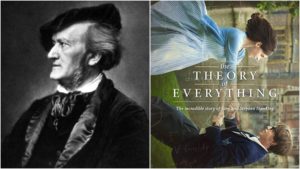
Opera Meets Film: Wagner’s Music Emphasizes Stephen Hawkings’ Status As Legend In ‘The Theory of Everything’
By David Salazar“Opera Meets Film” is a feature dedicated to exploring the way that opera has been employed in cinema. We will select a section or a film in its entirety, highlighting the impact that utilizing the operatic form or sections from an opera can alter our perception of a film that we are viewing. This week’s installment features “The Theory of Everything.”
Legendary physicist Stephen Hawking’s taste in music is almost as legendary as the major scientific works.
One composer that he famously took a liking to was Richard Wagner, who would become a major help to him in coping with his fateful diagnosis of Motor Neuron Disease.
“After I was diagnosed with Motor Neurone disease in 1963, I turned to Wagner as someone who suited the dark and apocalyptic mood I was in,” he famously said. “The four operas of the Ring Cycle are Wagner’s greatest work. I went to see them at Bern in Germany with my sister in 1964. I didn’t know The Ring well at the time and “Die Walküre” made a tremendous impression on me.”
It is no surprise then, that James Marsch’s biopic “The Theory of Everything” brings that very composer into the telling of Hawking’s life.
We encounter the German master’s music on two occasions. The first comes early in the film (around the 10-minute mark) when Hawkings is sleeping in from class and asks his friend to put on some Wagner for him so that he can take on a big assignment. When his friend doesn’t oblige, Hawkings himself turns on the opening of “Die Walküre,” specifically the close of the prelude where Siegmund enters into Hunding’s abode and will shortly meet with Sieglinde.
The music’s intense brooding foreshadows the imminent challenge that the young scientist will face. In this very scene, Marsch cuts to a closeup of Hawkings accidently spilling a cup of coffee all over some papers; the deliberate choice of the closeup makes it clear to the audience that this accident is important to keep in mind. Juxtaposed with the music, the sense of foreboding is only strengthened.
Wagner reappears around the middle of the film at another crucial moment in Hawking’s growing physical ailments. If Wagner presaged the start of his plight with “Die Walküre,” Götterdämmerung” will serve to bring about the challenging transition in his life where he would have to learn to communicate in a new manner. Hawkings is actually at the opera watching the final part of the “Ring Cycle” when he suddenly starts feeling unwell. He coughs up blood and is carried off by paramedics. The piece that is playing during this moment is “Siegfried’s Death and Funeral music,” whereupon the great hero is carried off in ceremonial fashion.
Most stagings showcase men carrying the prone body on their shoulders, much in the same manner as the paramedics mount Hawkings onto a stretcher. This imagery, coupled with the music, creates a rather strong suggestion of Hawkings as more than just a man, but a mythical hero and legend, much like the Wagnerian characters. In modern culture, he is undeniably seen in that manner in popular culture as one of the great heroes of the scientific community.
After this scene, Hawkings’ life hangs in the balance as he relies on life support; but he ultimately survives, continuing his journey and ultimately learning a new means of communication.
The film, while centering on his first wife Jane, portrays Hawkings as a hero who, through the support of those around him, overcomes his illness to become one of the most admired men of the 20th century. The use of Wagner’s music in “The Theory of Everything,” isn’t only a reference to his real-life fascination with the composer, but a means of emphasizing his legendary status.


